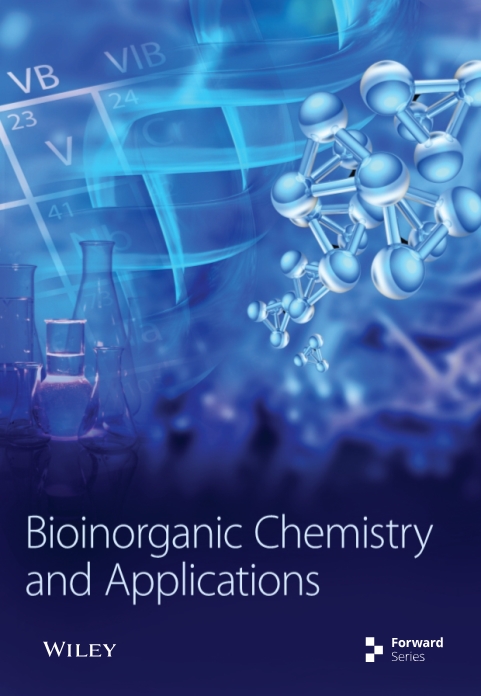新的锡(IV)和有机锡(IV)配合物与混合硫代氨基甲酸酮/腙配体:合成、晶体结构和抗增殖活性
IF 4.1
3区 化学
Q1 BIOCHEMISTRY & MOLECULAR BIOLOGY
引用次数: 0
摘要
如今,寻找低毒性、高选择性的新型化疗药物已成为人们关注的焦点。本文报告了一种中性硫代氨基甲酸酮/腙配体(L1H2)和氯盐([L1H3]Cl)的合成和表征、三种二甘锡(IV)配合物和一种与锡(IV)的配合物。这些化合物通过红外光谱、质谱、1H、13C 和 119Sn NMR、119Sn CP/MAS NMR 以及单晶 X 射线衍射进行了全面表征。这些有机锡化合物的经验公式为 [SnR2L1](R = Me、Bu 和 Ph),但在固态下,由于吡啶氮的弱配位,它们是具有七个配位数的聚合体,而在溶液中,聚合体结构消失,形成六配位单体。与 SnI4 反应会产生[Sn (L1)2]-EtOH 复合物,其中的金属呈扭曲的十二面体排列。我们评估了配体的两种形式和四种配位化合物对 MDA-MB-231、HeLa、PC3 和 HepG2 癌细胞株以及 WI-38 正常细胞株的抗增殖活性,所有化合物的活性都高于作为标准对照的顺铂。为了研究其作用模式,我们选择了含苯基取代基的活性最高的复合物,并使用了三阴性乳腺癌细胞株 MDA-MB-231。结果表明,该复合物可通过产生活性氧和破坏线粒体膜电位诱导细胞凋亡。本文章由计算机程序翻译,如有差异,请以英文原文为准。
New Tin (IV) and Organotin (IV) Complexes with a Hybrid Thiosemicarbazone/Hydrazone Ligand: Synthesis, Crystal Structure, and Antiproliferative Activity
Nowadays, the search for new chemotherapeutic agents with low toxicity and high selectivity is a major concern. In this paper, we report the synthesis and characterization of a hybrid thiosemicarbazone/hydrazone ligand in its neutral form (L1H2) and as the chloride salt ([L1H3]Cl)-, three diorganotin (IV) complexes, and one complex with Sn (IV). The compounds have been fully characterized by IR, mass spectra, 1H, 13C, and 119Sn NMR, 119Sn CP/MAS NMR, and by single crystal X-ray diffraction. The organotin compounds have the empirical formula [SnR2L1] (R = Me, Bu, and Ph), but in the solid state, they are polymeric species with seven coordination number due to weak coordination of the pyridine nitrogen, whereas in solution, the polymeric structure is lost to afford hexacoordinate monomeric species. Reaction with SnI4 yields complex [Sn (L1)2]·EtOH, with the metal in a distorted dodecahedral arrangement. We have evaluated the antiproliferative activity of the two forms of the ligands and the four coordination compounds against MDA-MB-231, HeLa, PC3, and HepG2 cancer cell lines, and WI-38 normal cell line, and all the compounds present higher activity than cisplatin, used as the standard control. To investigate the mode of action, we have selected the most active complex, containing phenyl substituents, and used the triple negative breast cancer cell line MDA-MB-231. The results show that the complex induces apoptotic cell death promoted by generation of reactive oxygen species and by disruption of mitochondrial membrane potential.
求助全文
通过发布文献求助,成功后即可免费获取论文全文。
去求助
来源期刊

Bioinorganic Chemistry and Applications
化学-生化与分子生物学
CiteScore
7.00
自引率
5.30%
发文量
105
审稿时长
>12 weeks
期刊介绍:
Bioinorganic Chemistry and Applications is primarily devoted to original research papers, but also publishes review articles, editorials, and letter to the editor in the general field of bioinorganic chemistry and its applications. Its scope includes all aspects of bioinorganic chemistry, including bioorganometallic chemistry and applied bioinorganic chemistry. The journal welcomes papers relating to metalloenzymes and model compounds, metal-based drugs, biomaterials, biocatalysis and bioelectronics, metals in biology and medicine, metals toxicology and metals in the environment, metal interactions with biomolecules and spectroscopic applications.
 求助内容:
求助内容: 应助结果提醒方式:
应助结果提醒方式:


